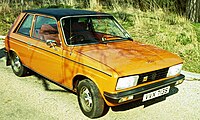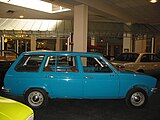Peugeot 104
| Peugeot | |
|---|---|
|
Peugeot 104 (1972)
|
|
| 104 | |
| Production period: | 1972-1988 |
| Class : | Small car |
| Body versions : | Limousine , station wagon , station wagon coupe |
| Engines: |
Petrol engines : 0.95-1.4 liters (33-68 kW) |
| Length: | 3283-3600 mm |
| Width: | 1520 mm |
| Height: | 1340-1391 mm |
| Wheelbase : | 2230-2419 mm |
| Empty weight : | 760-820 kg |
| successor |
Peugeot 205 Peugeot 106 |
The Peugeot 104 is a small car from the car manufacturer Peugeot , which was produced from late summer 1972 to mid-1988.
history
In September 1972 the only 3.62 m long small car 104 was presented. The body shape was designed by Paolo Martin . Originally the car was only available as a four-door hatchback sedan with a small trunk lid. In August 1973, a slightly shorter three-door coupé variant with a wheelbase smaller than the 104 Z was added. The coupe was also available with air-cooled boxer engines from Citroën as the Citroën LN and LNA.
In the 104 also had a newly developed four-cylinder - aluminum - Motor Premiere, in which Peugeot took many features from the drive of the larger model 204th On the one hand, the 104 had a very elaborate and modern engine with an aluminum engine block, V-shaped hanging valves and chain-driven overhead camshaft, but on the other hand, it did not follow Saab's established design with the gearbox next to the engine, but the outdated design philosophy with the gearbox under the engine and a common oil supply for gearbox and engine. In order to save on overall height, the drive block was installed at an angle of 72 degrees backwards so that the spare wheel could still be accommodated in the engine compartment. The engine developed an output of 33 kW (45 PS) from 954 cm³, the version with 1124 cm³ an output of 39 kW (53 PS). Later submitted engines with 1360 cm³ were available in three power levels with 53, 44 and 58 kW (72, 60 and 79 PS) for the French market.
As part of the facelift in July 1976, the four-door model was also available as a five-door model with a large tailgate at an additional cost .
Studies and prototypes
In 1975, Peugeot developed a four-door notchback sedan , a four-door station wagon , a closed delivery van and a pickup to complement the series . However, these variants did not go beyond the prototype status and were only occasionally used in-house in factory traffic.
Studies such as the Pininfarina Peugette roadster and the EVS security vehicle were also based on the 104 series.
Sister models
The 104 was the first car in which Peugeot carried out extensive badge engineering :
Citroën LN / LNA
In the fall of 1976 PSA presented the Citroën LN , which used the body of the 104 Z, but in which a slightly modified two-cylinder boxer engine from the Dyane was used - a unit that was derived from the original Citroën 2CV engine , but instead of three had two crankshaft bearings and an electronic ignition.
Instead of the square headlights in Peugeot style, round headlights similar to the one on the Dyane were used. In the interior, attempts were made to convey a Citroën ambience with a single-spoke steering wheel. Many Citroën customers were disappointed, however, as the badge engineering was too obvious and the usual extravagance of the brand had given way to a sober common parts strategy of a large corporation.
At the end of 1978 the LN - now called the Citroën LNA - was equipped with the Peugeot four-cylinder engine, but only in the versions with 45 and 50 hp (Peugeot 104 to 79 hp, later even 93 hp). The LN (A) was only offered as a three-door version with a short wheelbase. Citroën Visa, based on the 104 platform, was available to Citroën customers who wanted to purchase a five-door model .
Typically Citroën, "LN" was an onomatopoeic allusion to Hélène or Héléna . Because of its unusually short body, it was given the same nickname as the singer Édith Piaf : "Sparrow of Paris".
Talbot Samba
At the beginning of 1982 the Talbot Samba appeared , also only as a three-door, but since the start of sales with the entire range of four-cylinder engines. The Samba was the only one of the three vehicles that was also available as a convertible manufactured by Pininfarina from late summer 1982 to late 1985 .
The hatchback was sold until the Talbot brand was discontinued in the spring of 1986.
successor
The successors to the three models were the Peugeot 205 introduced in spring 1983 and the Citroën AX, which was built from autumn 1986 .
After the introduction of the Peugeot 205, Peugeot stopped selling the 104 in almost all markets except France in early 1984 . Sales ended there in the summer of 1988 too, and the 100 series was only continued again with the Peugeot 106 , which appeared in autumn 1991 .
Web links
| Timeline of the Peugeot models since 1945 | ||||||||||||||||||||||||||||||||||||||||||||||||||||||||||||||||||||||||||||
|---|---|---|---|---|---|---|---|---|---|---|---|---|---|---|---|---|---|---|---|---|---|---|---|---|---|---|---|---|---|---|---|---|---|---|---|---|---|---|---|---|---|---|---|---|---|---|---|---|---|---|---|---|---|---|---|---|---|---|---|---|---|---|---|---|---|---|---|---|---|---|---|---|---|---|---|---|
| Type | 40s | 50s | 60s | 70s | 80s | 90s | 2000s | 2010s | 2020s | |||||||||||||||||||||||||||||||||||||||||||||||||||||||||||||||||||
| 5 | 6th | 7th | 8th | 9 | 0 | 1 | 2 | 3 | 4th | 5 | 6th | 7th | 8th | 9 | 0 | 1 | 2 | 3 | 4th | 5 | 6th | 7th | 8th | 9 | 0 | 1 | 2 | 3 | 4th | 5 | 6th | 7th | 8th | 9 | 0 | 1 | 2 | 3 | 4th | 5 | 6th | 7th | 8th | 9 | 0 | 1 | 2 | 3 | 4th | 5 | 6th | 7th | 8th | 9 | 0 | 1 | 2 | 3 | 4th | 5 | 6th | 7th | 8th | 9 | 0 | 1 | 2 | 3 | 4th | 5 | 6th | 7th | 8th | 9 | 0 | |
| Microcar | ion | |||||||||||||||||||||||||||||||||||||||||||||||||||||||||||||||||||||||||||
| 106 | 107 | 108 | ||||||||||||||||||||||||||||||||||||||||||||||||||||||||||||||||||||||||||
| Small car | 104 | 205 | 206 | |||||||||||||||||||||||||||||||||||||||||||||||||||||||||||||||||||||||||
| 202 | 207 | 208 I. | 208 II | |||||||||||||||||||||||||||||||||||||||||||||||||||||||||||||||||||||||||
| Compact class | 204 | 301 | ||||||||||||||||||||||||||||||||||||||||||||||||||||||||||||||||||||||||||
| 203 | 304 | 305 | 306 | 307 | 308 I. | 308 II | ||||||||||||||||||||||||||||||||||||||||||||||||||||||||||||||||||||||
| Lower middle class | 309 | 408 I. | 408 II | |||||||||||||||||||||||||||||||||||||||||||||||||||||||||||||||||||||||||
| Middle class | 403 | 404 | 405 | 406 | 407 | |||||||||||||||||||||||||||||||||||||||||||||||||||||||||||||||||||||||
| 505 | 508 I. | 508 II | ||||||||||||||||||||||||||||||||||||||||||||||||||||||||||||||||||||||||||
| upper middle class | 504 | |||||||||||||||||||||||||||||||||||||||||||||||||||||||||||||||||||||||||||
| 604 | 605 | 607 | ||||||||||||||||||||||||||||||||||||||||||||||||||||||||||||||||||||||||||
| Coupe | RCZ | |||||||||||||||||||||||||||||||||||||||||||||||||||||||||||||||||||||||||||
| 404 coupe | 504 coupe | 406 coupe | 407 coupe | |||||||||||||||||||||||||||||||||||||||||||||||||||||||||||||||||||||||||
| Minivan | 1007 | |||||||||||||||||||||||||||||||||||||||||||||||||||||||||||||||||||||||||||
| Crossover | 2008 I. | 2008 II | ||||||||||||||||||||||||||||||||||||||||||||||||||||||||||||||||||||||||||
| 3008 I. | ||||||||||||||||||||||||||||||||||||||||||||||||||||||||||||||||||||||||||||
| SUV | 3008 II | |||||||||||||||||||||||||||||||||||||||||||||||||||||||||||||||||||||||||||
| 4008 | ||||||||||||||||||||||||||||||||||||||||||||||||||||||||||||||||||||||||||||
| 4007 | ||||||||||||||||||||||||||||||||||||||||||||||||||||||||||||||||||||||||||||
| 5008 II | ||||||||||||||||||||||||||||||||||||||||||||||||||||||||||||||||||||||||||||
| Compact van | 5008 I. | |||||||||||||||||||||||||||||||||||||||||||||||||||||||||||||||||||||||||||
| Van | 806 | 807 | ||||||||||||||||||||||||||||||||||||||||||||||||||||||||||||||||||||||||||
| Off-road vehicle | P4 | |||||||||||||||||||||||||||||||||||||||||||||||||||||||||||||||||||||||||||
| Pick up | 403 truck | 404 pick up | 504 pick up | Pick up | Land trek | |||||||||||||||||||||||||||||||||||||||||||||||||||||||||||||||||||||||
| High roof combination | Traveler | |||||||||||||||||||||||||||||||||||||||||||||||||||||||||||||||||||||||||||
| Box van | 205 Multi / Fourgonnette | |||||||||||||||||||||||||||||||||||||||||||||||||||||||||||||||||||||||||||
| Bipper | ||||||||||||||||||||||||||||||||||||||||||||||||||||||||||||||||||||||||||||
| partner | partner | Rifter | ||||||||||||||||||||||||||||||||||||||||||||||||||||||||||||||||||||||||||
| Transporter | D3 | D4 | J7 | J9 | Expert | Expert | Expert | |||||||||||||||||||||||||||||||||||||||||||||||||||||||||||||||||||||
| J5 | boxer | boxer | ||||||||||||||||||||||||||||||||||||||||||||||||||||||||||||||||||||||||||
|
|
||||||||||||||||||||||||||||||||||||||||||||||||||||||||||||||||||||||||||||
| Timeline of the Peugeot models from 1889 to 1944 | ||||||||||||||||||||||||||||||||||||||||||||||||||||||||
|---|---|---|---|---|---|---|---|---|---|---|---|---|---|---|---|---|---|---|---|---|---|---|---|---|---|---|---|---|---|---|---|---|---|---|---|---|---|---|---|---|---|---|---|---|---|---|---|---|---|---|---|---|---|---|---|---|
| Type | 1880s | 1890s | 1900s | 1910s | 1920s | 1930s | 1940s | |||||||||||||||||||||||||||||||||||||||||||||||||
| 9 | 0 | 1 | 2 | 3 | 4th | 5 | 6th | 7th | 8th | 9 | 0 | 1 | 2 | 3 | 4th | 5 | 6th | 7th | 8th | 9 | 0 | 1 | 2 | 3 | 4th | 5 | 6th | 7th | 8th | 9 | 0 | 1 | 2 | 3 | 4th | 5 | 6th | 7th | 8th | 9 | 0 | 1 | 2 | 3 | 4th | 5 | 6th | 7th | 8th | 9 | 0 | 1 | 2 | 3 | 4th | |
| Small car | 1 | 2 | 3 / 4 | 5 / 6 / 7 / 8 | 21 / 24 / 30 / 31 | 37 | 54 | 57 | 69 "Bébé" | B P1 / B3 / P1 "Bébé" [1] | 161/172 "Quadrilette" | 190 | ||||||||||||||||||||||||||||||||||||||||||||
| 26 / 27 / 28 | 48 | 126 | 201 | 202 ... | ||||||||||||||||||||||||||||||||||||||||||||||||||||
| Compact class | 14 / 15 / 25 | 56 | 58 | 68 | VA / VC / VY [1] | V2C / V2Y [1] | VD / VD2 [1] | 159 | 163/163 BS | 301 | 302 | |||||||||||||||||||||||||||||||||||||||||||||
| 33 / 36 | 63 | 99 | 108 | 118 | 125 | 173 / 177 / 181 / 183 | ||||||||||||||||||||||||||||||||||||||||||||||||||
| Middle class | 9 / 10 / 11 / 12 | 16 / 17 / 19 / 32 | 49/50 | 65/67 | 77 | 78 | 88 | 127 | 143 | 153 | 153 B / BR | 176 | 401 | 402 | ||||||||||||||||||||||||||||||||||||||||||
| 18th | 39 | 61 | 71 | 81 | 96 | 106 | 116 | 126 | 138 | 175 | ||||||||||||||||||||||||||||||||||||||||||||||
| upper middle class | 23 | 42/43/44 | 62 | 72 | 82 | 92 | 104 | 112/117/122/130/134 | 139 | 145/146/148 | 174 / 184 | 601 | ||||||||||||||||||||||||||||||||||||||||||||
| 66 | 76 | 83 | 93 | 135 | 156 | |||||||||||||||||||||||||||||||||||||||||||||||||||
| Upper class | 80 | 103 | 113 | 141 | 147/150 | |||||||||||||||||||||||||||||||||||||||||||||||||||
| 85 | 95 | 105 | ||||||||||||||||||||||||||||||||||||||||||||||||||||||
| Convertible / Spider | 91 | 101/120 | 133 / 111/129/131 | 136 | 144 | |||||||||||||||||||||||||||||||||||||||||||||||||||
| Box van | 13 | 22nd | 34/35 | |||||||||||||||||||||||||||||||||||||||||||||||||||||
| minibus | 20 / 29 | 107 | ||||||||||||||||||||||||||||||||||||||||||||||||||||||







